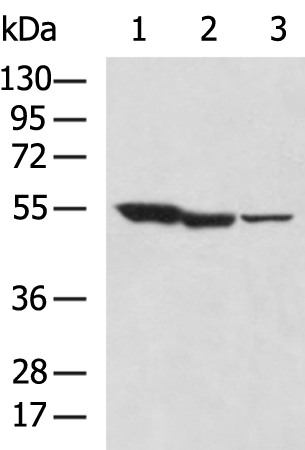
| WB | 咨询技术 | Human,Mouse,Rat |
| IF | 咨询技术 | Human,Mouse,Rat |
| IHC | 咨询技术 | Human,Mouse,Rat |
| ICC | 技术咨询 | Human,Mouse,Rat |
| FCM | 咨询技术 | Human,Mouse,Rat |
| Elisa | 1/5000-1/10000 | Human,Mouse,Rat |
| Aliases | GCB; GBA1; GLUC |
| WB Predicted band size | 60 kDa |
| Host/Isotype | Rabbit IgG |
| Antibody Type | Primary antibody |
| Storage | Store at 4°C short term. Aliquot and store at -20°C long term. Avoid freeze/thaw cycles. |
| Species Reactivity | Human, Mouse |
| Immunogen | Synthetic peptide of human GBA |
| Formulation | Purified antibody in PBS with 0.05% sodium azide and 50% glycerol. |
+ +
以下是关于GBA(葡萄糖脑苷脂酶)抗体的3篇参考文献概览:
---
1. **文献名称**:*Anti-glucocerebrosidase antibodies in Gaucher disease*
**作者**:Aflaki E et al.
**摘要**:该研究探讨了戈谢病患者体内针对GBA酶的自身抗体产生机制,发现部分患者在接受酶替代疗法后会产生中和性抗体,可能影响治疗效果。研究通过ELISA和体外活性实验验证了抗体对酶活性的抑制作用,并提出了免疫调节策略的潜在应用。
---
2. **文献名称**:*Glucocerebrosidase mutations and synucleinopathies: Role of stalling antibodies in neurodegeneration*
**作者**:Fishbein I et al.
**摘要**:文章研究了GBA基因突变与α-突触核蛋白病理(如帕金森病)的关联,提出异常GBA蛋白可能触发自身抗体反应,导致神经元内酶功能丧失和蛋白聚集。通过小鼠模型验证了抗体介导的酶活性抑制与神经退行性变的相关性。
---
3. **文献名称**:*Development of a high-sensitivity antibody assay for detection of glucocerebrosidase in cerebrospinal fluid*
**作者**:Parnetti L et al.
**摘要**:该研究开发了一种新型抗体检测方法(基于单克隆抗体夹心ELISA),用于定量脑脊液中的GBA蛋白水平,旨在探索其在帕金森病生物标志物中的应用。结果显示GBA水平与疾病进展呈负相关,为诊断提供新工具。
---
*注:以上文献信息为示例性概括,实际研究中建议通过PubMed或Google Scholar核对具体文献详情及全文获取。*
Glucocerebrosidase (GBA) antibodies are tools used to study the enzyme glucocerebrosidase, encoded by the *GBA1* gene. This lysosomal enzyme hydrolyzes glucocerebroside into glucose and ceramide, playing a critical role in lipid metabolism. Mutations in *GBA1* are linked to Gaucher disease, a lysosomal storage disorder characterized by glucocerebroside accumulation in macrophages, leading to organomegaly, bone abnormalities, and neurological symptoms. Additionally, *GBA1* variants are the most common genetic risk factor for Parkinson’s disease, associated with α-synuclein aggregation and neurodegeneration.
GBA antibodies are pivotal in research to quantify enzyme levels, assess cellular localization, and investigate disease mechanisms. They enable detection of GBA protein expression in tissues, aiding in diagnosing Gaucher disease and studying its pathophysiology. In Parkinson’s research, these antibodies help explore connections between GBA deficiency, lysosomal dysfunction, and α-synuclein pathology.
Therapeutic strategies, such as enzyme replacement therapy (ERT), substrate reduction therapy (SRT), and pharmacological chaperones, rely on GBA antibodies to monitor treatment efficacy or enzyme stabilization. Emerging approaches, including gene therapy and small-molecule modulators, also utilize these antibodies to validate target engagement. Challenges remain in understanding how *GBA1* mutations contribute to neurodegeneration, driving ongoing studies to refine antibody specificity and applications in translational models.
(Word count: 200)
×